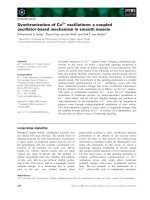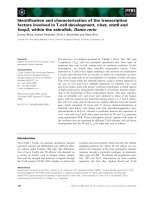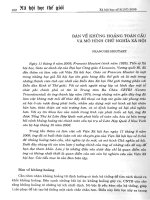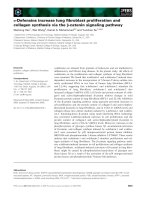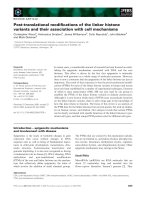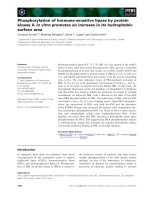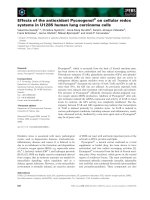Báo cáo khoa học: "SemiIntensity-modulated radiation therapy (IMRT) vs. 3D conformal radiotherapy (3DCRT) in locally advanced rectal cancer (LARC): dosimetric comparison and clinical implications" pptx
Bạn đang xem bản rút gọn của tài liệu. Xem và tải ngay bản đầy đủ của tài liệu tại đây (1.17 MB, 9 trang )
METH O D O LOG Y Open Access
Intensity-modulated radiation therapy (IMRT) vs.
3D conformal radiotherapy (3DCRT) in locally
advanced rectal cancer (LARC): dosimetric
comparison and clinical implications
Leire Arbea
*
, Luis Isaac Ramos, Rafael Martínez-Monge, Marta Moreno, Javier Aristu
Abstract
Purpose: To compare target dose distribution, comformality, normal tissue avoidance, and irradiated body volume
(IBV) in 3DCRT using classic anatomical landmarks (c3DCRT), 3DCRT fitting the PTV (f3DCRT), and intensity-
modulated radiation therapy (IMRT) in patients with locally advanced rectal cancer (LARC).
Materials and methods: Fifteen patients with LARC underwent c3DCRT, f3DCRT, and IMRT planning. Target
definition followed the recommendations of the ICRU reports No. 50 and 62. OAR (SB and bladder) constraints
were D5 ≤ 50 Gy and Dmax < 55 Gy. PTV dose prescription was defined as PTV95 ≥ 45 Gy and PTVmin ≥ 35 Gy.
Target coverage was evaluated with the D95, Dmin, and Dmax. Target dose distribution and comformality was
evaluated with the homogeneity indices (HI) and Conformity Index (CI). Normal tissue avoidance of OAR was
evaluated with the D5 and V40. IBV at 5 Gy (V5), 10 Gy (V10), and 20 Gy (V20) were calculated.
Results: The mean GTV95, CTV95, and PTV95 doses were significantly lower for IMRT plans. Target dose distribution
was more inhomogeneous after IMRT planning and 3DCRTplans had significantly lower CI. The V40 and D5 values
for OAR were significantly reduced in the IMRT plans .V5 was greater for IMRT than for f3DCRT planning (p < 0.05)
and V20 was smaller for IMRT plans(p < 0.05).
Conclusions: IMRT planning improves target conformity and decreases irradiation of the OAR at the expense of
increased target heterogeneity. IMRT planning increases the IBV at 5 Gy or less but decreases the IBV at 20 Gy or
more.
Introduction
Preoperative chemoradiation (CRT) is the standard neoad-
juvant treatment in patients with LARC (T3 and/or N+)
[1]. The German CAO/ARO/AIO 94 trial confirmed that,
compared to postoperative CRT in LARC, preoperative
CRT produces significantly lower local recurrence rates,
less acute and chronic toxicity, and an increased rate of
sphincter preservation [2]. However, despite its improved
compliance rate, preoperative CRT still results in consider-
able acute gastrointestinal toxicity. Acute grade 3 or
greater diarrhea is observed in 12-25% of the patients,
depending on the mode of 5-FU delivery. Combining new
chemotherapy agents concurrently with preoperative
radiation such as capecitabine and oxaliplatin has resulted
in similar rates of acute toxicity [1,3-5]. Small bowel (SB)
toxicity is increased with wider irradiated fields, higher
radiation dosages, inappropriate irradiation techniques,
and larger irradiated SB volumes[6]. The relationship
between SB irradiation and grade 3 diarrhea has been
observed at all dose levels during preoperative CRT[7],
and some dosimetric quantifiers, such as V15 (the absolute
volume of SB receiving at least 15 Gy) [8] have been pos-
tulated to rep resent a reliabl e cut-off dur ing dose pla n
evaluation.
IMRT produces highly conformal dose distributions in
the target volumes and minimizes the dose received by
adjacent dose-limiting structures. This ability of IMRT
to decrease bowel irradiation has been widely reported
* Correspondence:
Department of Oncology, Clínica Universidad de Navarra, Pamplona, Spain
Arbea et al. Radiation Oncology 2010, 5:17
/>© 2010 Arbea et al; licensee BioMed Central Ltd. This is an Open Access a rtic le distributed under the terms of the Creative Commons
Attribution License ( which permits unrestri cted use, distribution, and reproduction in
any medium, provided the original work is properly cited.
in gynecologic and prostate cancer studies([ 9,10]). How-
ever, dosimetric studies comparing IMRT and 3DCRT
in LARC are scarce ([7,11,12]) and include small pa tient
samples that range from 5 to 8.
We designed this planning study to compare the
potential dosimetric advantages of IMRT and conven-
tional 3DCRT using classic anatomical landmarks
(c3DCRT) and 3DCRT fitting the field edges of the PTV
(f3DCRT) in a larger patient sample o f 15 individuals.
Forty-five dosimetric plans were generated for analysis.
The following planning results were evaluated and com-
pared: target coverage and target dose distribution; com-
formality; normal tissue avoidance, and irradiated body
volume.
Materials and methods
Fifteen consecutive patients with LARC underwent
c3DCRT, f3DCRT, and IMRT planning at the Radiation
Oncology Division of the University of Navarre, Spain,
from March 2003 to September 2003. Two patients had
tumors arising in the upper third of the rectum, eight in
themiddlethird,andfiveinthelowerthird.Ten
tumors were staged by echoendoscopy as uT3N+ and
five as uT3N0. Patients were immobilized in the prone
position using a combination of a foam cushion and a
prone head cushion. Setup marks were drawn on the
patient’s skin and the cushion after laser alignment. A
non contrast-enhanced planning CT scan was per-
formed using a diagnostic CT scanner (Somatron Plus
4, Siemens Oncology Care Systems, Heidelberg, Ger-
many) with a flat table insert. Patients were instructed
to have an empty bladder before CT scan. The scan
extended from the L2 vertebral body to 2 cm below the
perineum, and axial i mages were obtained at 5 mm
intervals and imported to the planning system (Helax-
TMS, Nucletron Scandinavia, Uppsala, Sweden).
Target definition followed the recommendations of the
ICRU reports No. 50 and 62[13]. The GTV-T and GTV-
N were delineated using information from the diagnostic
CT and the Endoscopic Ul trasound (EUS). The clinical
target volume (CTV) included the GTV-T and GTV-N
(if any), the presacral nodes, the complet mesorectum
and the common and internal iliac lymph nodes. The
PTV was generated w ith an asymmetrical margin
around the CTV. In areas in which the t umor was close
to the SB and bladder, a 5-mm expansion was used
while a 10-mm margin was used in the rest of the
volume. The organ at risk volumes (OARVs) outlined
were the bladder, the rectum from the sphincter to the
sigmoid (including the GTV-T), and the SB. The SB was
outlined 1 cm above and below the PTV, and the blad-
der was fully contoured.
For c3DCRT planning, a four-field technique using the
classic anatomical references was used [14] regardeless
of the PTV designed. The superior edge of AP-PA por-
tals was placed between the sacral promontory and the
L4-L5 interspace, and the inferior border was placed on
the ischial tuberosities. If the tumor was located in the
lower third of the rectum, the inferior edge was dis-
placed inferiorly to include the perineum. The lateral
borders of AP-PA portals were placed to provide ade-
quate coverage of the pelvic sidewalls with a 1-cm mar-
gin. The posterior margin for lateral fields was placed
1.5-2.0 cm posterior to the anterior border of the
sacrum. The anterior border of the lateral fields usually
covered at least the posterior border of the vagina or
the prostate, the anterior extent of the primary rectal
tumor, and the anterior edge of the sacral promontory.
Customized shielding was performed using 1-cm leaves.
In f3DCRT planning, the beams of a typical four-field
arrangement were shaped to the PTV with 1-cm leaves.
A 45 Gy dose delivered with 15 MV photons was pre-
scribed to the PTV
95
(the minimal dose received by 95%
of the PTV) for the 3DCRT plans. Photon dose calcula-
tion in tridimensional radiotherapy planning was made
using the pencil beam with the Iwasaki algorithm to
correct inhomogeneities [15].IMRTplanning procedure
has been described previously [16,17]. Treatment plan-
ning was performed using the KonRad inverse planning
system, version 2. 0 (Siemens Oncology Care Systems).
Seven coplanar equi-spaced fields (gantry angles 0°, 51°,
103°, 154°, 20 6°, 257°, and 308°) were generated with a
median of 51 segments (range, 44 to 67). The isocenter
was placed at the geometric center of the PTV. The
hierarchy of dose constraints and dose prescription was
asfollows:first,SB;second,PTV;third,bladder.Plans
were accepted when the PTV
95
was ≥ 45 Gy , the dose
received by 5% of the SB (SB D
5
)was≤ 50 Gy, the
PTV
min
(minimal dose to the PTV ) was ≥ 35 Gy, and
maximal SB dose (SB
max
) was 55 Gy. Dose const raints
for the bladder included a maximal dose (Bla dder
max
)of
55 Gy and a minimal dose received by 5% of the bladder
(Bladder D
5
) of 50 Gy. No specific rectum or external
volume constraints were used. IMRT was delivered with
15 MV photons generated in a Mevatron Primus and
Oncor linear accelerator (Siemens Oncology Care Sys-
tems, Concord, CA). The dose calculation algorithm was
also pencil beam with 0.25 cm of voxel size. Konrad cal-
culate the optimum fluence based on physical con-
straints followed by aperture calculation of the segments
[18].
Dosimetric Evaluation
The target coverage and target dose distribution were
evaluated in the GTV, CTV, and PTV obtaining the fol-
lowing parameters for each of the three treatment mod-
alities: minimal target dose (GTV
min
,CTV
min
,PTV
min
),
maximal target dose (GTV
max
,CTV
max
,PTV
max
)
Arbea et al. Radiation Oncology 2010, 5:17
/>Page 2 of 9
calculated in all voxels of target volume, minimal dose
to 95% of the volume (GTV
95
,CTV
95
,PTV
95
), and
homogeneity index (HIG
TV
, HIC
TV
,HIP
TV
). The homo-
geneity index (HI) was defined as the standard deviation
of the normalized differential DVH curve [19] within a
target volume.
The degree of comformality was evaluated with a con-
formity index (CI) that was defined as the ratio between
the target volume (PTV) and the irradiated volume at
specified prescription dose (Vol PTV/Vol IR95%) [20].
Normal tissue (bladder, SB, and rectum) avoidance
was evaluated using the following parameters: minimal
dose received by 5% or less of the volume (Bladder D
5
,
SB D
5
, Rectum D
5
) and absolute organ volume receiving
40 Gy or more (Bladder V
40
,SBV
40
, Rectum V
40
).
Finally, irradiated body volumes at the dose levels of 5
Gy (V
5
), 10 Gy (V
10
), and 20 Gy (V
20
) were calculated for
each treatment modality. We also calculated the average
cut-off poi nt doses at which the irradiated body volumes
were significantly different between treatment modalities.
Plans were compared using the Kruskal Wallis test. If
positive results, a paired U-Mann-Whitney test was
applied with the statement that the IMRT is a reference.
WecompareIMRTvsf3DCRTandIMRTvsc3DCRT
and the differences were considered as statistically sig-
nificant at the p ≤ 0.05 level.
Results
Target Coverage and Target Dose Distribution
The c3DCRT a nd f3DCRT plans met the prescription
goal of PTV
95
≥ 45 Gy in all cases. However, the pre-
scription goal of PTV
95
≥ 45 Gy was not reached in two
IMRT patients (44.8 Gy and 44.4 Gy, respectively).
CTV
95
was lower than 45 Gy in one IMRT case (44.9
Gy), and GTV
95
was ≥ 45 Gy in all cases. The mean
GTV
95
,CTV
95
,andPTV
95
doses were found to be sig-
nificantly lower for IMRT plans than for c3DCRT and
f3DCRT plans. Table 1 list the D
95
,D
min
,andD
max
values for the target volumes. DVHs of the target
volumes with the three different techniques are shown
in Figure 1. Finally, the dose distribution across the tar-
get volumes was less homogeneous after IMRT planning
than after c3DCRT or f3DCRT planning. This difference
was statistically significant (p < 0.05) for all the volumes
analyzed (Table 2).
Comformality
The median volume of the PTV contoured in th e 15
patients was 1211.6 cc (range, 870.2 to 1694.7 cc). IMRT
planning had the highest level of comformality compared
to the 3DCRT plans (Table 2). Th e average CI of the
IMRT plans was 0.8, and the average CI of c3DCRT and
f3DCRT planning were 0.5 and 0.6, respectively, (p <
0.05). Figure 2 shows representative axial CT slides that
show the isodose distributions obtained with the three
treatment modal ities. Better dose conf ormation of the
target volumes was observed after IMRT planning.
Normal Tissue Avoidance
Table 3 and Figure 3 summarize the mean D5 and V40
values for the bladder, SB, and rectum. IMRT planning
produced significantly lower D5 and V40 values for the
bladder and the SB (p < 0.05). However, rectal values
were not statistically different.
Irradiated Body Volume
The body volume receiving ≥ 5 Gy (V5) was significantly
larger after IMRT planning than after f3DCRT planning
(p < 0.05), but no statistical differences were found
between IMRT and c3DCRT planning. No differences in
Table 1 Dosimetric summary of target volumes
D
95
(Gy) Dmin (Gy) Dmax(Gy)
c3DCRT f3DCRT IMRT c3DCRT f3DCRT IMRT c3DCRT f3DCRT IMRT
GTV mean 47.5 47.5 46.9 46.7 46.6 45.1 50.2 50.3 51.6
SD 0.6 0.7 2.3 0.4 0.6 2.0 1.0 1.0 2.7
pp
1
< 0.05 p
2
< 0.05 Ref p
1
< 0.05 p
2
< 0.05 Ref p
1
=0.2 p
2
=0.3 Ref
PTV mean 47.1 46.9 45.7 39.5 42.2 39.2 51.1 51.2 54.0
SD 0.5 0.5 0.8 4.2 1.2 1.7 0.6 0.5 2.6
pp
1
< 0.05 p
2
< 0.05 Ref p1 = 0.4 p
2
< 0.05 Ref p
1
< 0.05 p
2
< 0.05 Ref
c3DCRT: classic tridimensional conformal radiotherapy;
f3DCRT: fitting tridimensional conformal radiotherapy,
IMRT: intensity modulated radiation therapy;
D
95
: minimal dose to 95% of the volume;
GTV: gross tumor volume;
PTV: planning target volume;
SD: Standard deviation;
p1: c3DCRT vs IMRT;
p2: f3DCRT vs IMRT;
Ref:Referencevalue
Arbea et al. Radiation Oncology 2010, 5:17
/>Page 3 of 9
V10 were observed among the 3 treatment modalities.
However, V20 was signific antly smaller after IMRT
planning (Table 4). Volumetric analysis revealed that
when isodoses are less than 8.4 Gy(95 CI: 6.2-10.6), the
volumes of the isodoses from IMRT plans are larger
than the isodoses volumes from c3DCRT plans and
when isodoses are m ore than 15 Gy(95 CI:13.8-16.4),
the isodose volumes from IMRT plans are smaller than
the f3DCRT isodoses volumes (Figure 4).
Discussion
This study was designed to compare the degree of target
coverage and target dose distribution, comformality,
normal tissue avoidan ce, and amount of irradiated body
volume in IMRT, c3DCRT, and f3DCRT.
Target Coverage and Dose Distribution
The IMRT p lans failed to meet the prescription goal of
PTV
95
≥ 45 Gy in two out of 15 cases (44.8 Gy and 44.4
Gy), although the deviation was minimal (-0.4% and
-1.3%, respectively). These minor deviations were the
result of the normal tissue dose constraints. Duthoy et
al. [11] compared intensity-modulated arc therapy
(IMAT) with 3DCRT in LARC and did not observe dif-
ferences in the coverage of the PTV.
The limitations and potential difficulties inherent to
IMRT in the treatment of rectal cancer, i.e., organ motion,
volume variability, dose inhomogeneity, and integral dose,
must be considered. The rapid dose drop-off beyond tar-
get volumes, characteristic of IMRT, the internal target
and organ at risk motion, a nd volume variability m ake
treatment success higher dependent on accurate determi-
nation of target position, shape, and size, than in 3DCRT.
Rectal organ motion has been described almost solely
in patients treated for prostate and bladder cancer. In
these studies, rectal volume changes were observed dur-
ing treatment, especially in the anterior wall and upper
half of the rectum[21-25]. Nuyttens et al.[26] studied
the variability of the CTV in rectal cancer due to inter-
nal organ motion during adjuvant treatment, but no
data have been published on the variability of the rectal
wall affected by tumor. The variation of rectal wall in
patients with LARC would be pr obably smaller due to
the fixation that can be confirmed by digital rectal
examination in 88% of stage II and III tumors [27]. The
influence of SB motion in IMRT f or rectal cancer has
been studied by Nuyttens et al [28]. In the preoperative
setting, the SB is located in the superior pelvis where
the posterior, lateral and anterior borders of the CTV
are all very stable, therefore, the CTV is not probably
influenced by SB motion and volume variability.
It is important to reably know the magnitude of inter-
nal organ motion, in order to assume a minimal varia-
bility to assure clinical reproducibility.
Based on these data, IMRT treatment planing goal
have to be the coverage of prescribed dose in the 95%
of PTV, and image verification becomes crucial.
Homogeneity is another issue that have to be explored
in IMRT plans. In our study, target dose d istribution
across the GTV, CTV, and PTV was less homogeneous
after IMRT planning than after c3DCRT or f3DCRT.
Figure 1 Target dose volume histograms comparison. DVH: dose-volume histogram. GTV: gross tumor volume. CTV: clinical target v olume.
PTV: planning target volume. c3DCRT: conventional tridimensional conformal radiotherapy (blue line). f3DCRT: modificated tridimensional
conformal radiotherapy (pink line). IMRT: intensity modulated radiation therapy (green line).
Table 2 Homogeneity and Conformity Index of Target
Volumes
HI CI
c3DCRT f3DCRT IMRT c3DCRT f3DCRT IMRT
GTV mean 0.8 0.8 1.1
SD 0.2 0.2 0.3
pp
1
< 0.05 p
2
< 0.05 Ref
PTV mean 1.1 1.1 1.6 0.5 0.6 0.8
SD 0.1 0.2 0.3 0.1 0.1 0.1
pp
1
< 0.05 p
2
< 0.05 Ref p
1
< 0.05 p
2
< 0.05 Ref
HI: homogeneity index;
CI: Conformity index
c3DCRT: classic tridimensional conformal radiotherapy;
f3DCRT: fitting tridimensional conformal radiotherapy,
IMRT: intensity modulated radiation therapy;
GTV: gross tumor volume;
CTV: clinical target volume;
PTV: planning target volume;
p
1:
c3DCRT vs IMRT
;
p
2:
f3DCRT vs IMRT;
Ref:Referencevalue
Arbea et al. Radiation Oncology 2010, 5:17
/>Page 4 of 9
Figure 2 Isodose distribution in a patient with a uT3N+ medial rectal cancer. planned with c3DCRT (A and D), f3DCRT (B and E) and IMRT
(C and F). The. orange line represents the 95% isodose. c3DCRT: conventional tridimensional conformal radiotherapy. f3DCRT: modificated
tridimensional conformal radiotherapy. IMRT: intensity modulated radiation therapy.
Table 3 OARV Parameters
D
5
(Gy) V
40
(cc)
c3DCRT f3DCRT IMRT c3DCRT f3DCRT IMRT
BLADDER mean 48.8 48.4 46.2 94.7 60.9 34.4
SD 0.5 0.5 4.1 66.2 26.5 24.9
pp
1
< 0.05 p
2
= 0.06 Ref p
1
< 0.05 p
2
< 0.05 Ref
SMALL BOWEL mean 49.2 49.0 46.2 178.3 140.3 68.9
SD 0.5 0.8 4.1 136.6 120.7 63.5
pp
1
< 0.05 p
2
< 0.05 Ref p
1
< 0.05 p
2
< 0.05 Ref
RECTUM mean 50.7 50.8 50.6 162.3 157.7
SD 0.6 0.6 2.3 55.7 56.5 54.8
pp
1
= 0.8 p
2
= 0.7 Ref p
1
= 0.8 p
2
= 0.9 Ref
OARV: Organs at risk volume
c3DCRT: classic tridimensional conformal radiotherapy;
f3DCRT: fitting tridimensional conformal radiotherapy,
IMRT: intensity modulated radiation therapy;
D5: minimal dose received by 5% of the OARV;
V40: volume receiving ≥ 40 Gy
GTV: gross tumor volume;
PTV: planning target volume;
p
1:
c3DCRT vs IMRT
;
p
2:
f3DCRT vs IMRT;
Ref: Reference value
Arbea et al. Radiation Oncology 2010, 5:17
/>Page 5 of 9
The standard deviation of the normalized differential
DVH curve across the PTV was 1.59 for IMRT, 1.12 for
f3DCRT, and 1.10 for c3DCRT (p < 0.05). These results
have been previously observed by other authors[12].
Other reports, however, have not shown an increased
heterogeneity across the target volume with IMRT plans
[7]. This fact may be relationated with the objective of
IMRT; if the goal is uniformity, IMRT achieve more
homogeneus plans, but if the goal is coverage, it could
be at the expense of more inhomogeneity. In these
cases, IMRT planning results in a trade-off between the
coverage of the target, avoidance of adjacent healthy
structures, and the inhomogeneity of the dose within
the target. The consequences of non-uniform dose dis-
tributions in smal l target sub-volume s may not be dele-
terious. Tumor control has been related to the mean
dose rather than to the minimum target absorbed dose
when the dose uniformity is low, and more sub-volumes
within the target volume may be advantageous [29].
Moreover, when inhomogeneity is present, it is impor-
tant discriminate between overdosage and underdosage.
If underdosing is observed, it is important to know the
magnitude, location, and volume o f the low dose
regions. A modest number of colds spots (small volumes
with moderate low dose) may not reduce tumor
response or tumor control probability [30,31]. Our plans
were visually checked to determine the location of cold
and hot spots. The regions receiving 45 Gy or less were
very small and were predominantly located on the ante-
rior portion of the external iliac nodal region, an area
with a low probability of tumor involvement. We also
checked hot spots within the PTV to make sure the
location out of some normal structures (i.e. sacral
plexus) that are relationated with toxicity.
SB Avoidance
IMRT plans produced a vast reduction in the mean SB
V40. The volume of SB receiving ≥ 40 Gy with IMRT
was roughly one third of the SB V40 irradiated with
c3DCRT (68.9 cc vs. 178.3 cc, p < 0.05) and one-half of
the SB irradiated with f3DCRT (68.9 cc vs. 140.3 cc, p <
0.05). The same findings were obtained when the frac-
tional SB D5 was used instead. The c3DCRT and
f3DCRT plans had higher SB D5 values than the IMRT
plan (49.2 Gy vs. 46.2 Gy , p < 0.05; 49.0 Gy vs. 46.2 Gy,
p < 0.05; respectively). When Duthoy et al. [11] com-
pared intensity-mo dulated arc therapy (IMAT) w ith
3DCRT in LARC, the mean dose to the SB was signifi-
cantly lower for the IMAT. A small retrospective plan-
ning study recently published by Guerrero et al. [12]
compared the dosimetric dist ributions generated by
IMRT and conventional 3DCRT plans in 5 patients. The
results showed that the bowel volume irradiated to 45
Gy and 50 Gy was significantly reduced with IMRT.
Tho et al. [7] performed additional IMRT planning in 8
LARC patients in whom the vo lume of SB included in
the prescription isodose generated with 3DCRT was too
large. Inverse planning reduced the median dose to the
SB by 5.1 Gy (p = 0.008), as well as the individual
volumes of SB receiving high and low dose irradiation.
Bladder Avoidance
IMRT also demonstrated a clear advantage in terms of
bladder sparing. The volume of bladder receiving ≥ 40
Gy with IMRT was approximately one third of the
Table 4 Irradiated Body Volume
c3DCRT f3DCRT IMRT
V5 (cc) 11484 10302 12164
p
1
= 0.43 p
2
< 0.05 Ref
V10 (cc) 9419 8416 9232
p
1
= 0.9 p
2
= 0.1 Ref
V20 (cc) 7781 6881 5764
p
1
< 0.05 p
2
< 0.05 Ref
c3DCRT: classic tridimensional conformal radiotherapy;
f3DCRT: fitting tridimensional conformal radiotherapy,
IMRT: intensity modulated radiation therapy;
V5: body volume receiving ≥ 5Gy;
V10: body volume receiving ≥ 10 Gy;
V20: body volume receiving ≥ 20 Gy;
p
1:
c3DCRT vs IMRT
;
p
2:
f3DCRT vs IMRT;
Ref: Reference value
Figure 3 Organ at risk dose volume histograms comparisson. c3DCRT: conve ntional tridimensional conformal radiotherapy (blue line).
f3DCRT: modificated tridimensional conformal radiotherapy (pink line). IMRT: intensity modulated radiation therapy (green line).
Arbea et al. Radiation Oncology 2010, 5:17
/>Page 6 of 9
bladder V40 irradiated with c3DCRT (34.4 cc vs. 94.7
cc, p < 0.05) and one half of the bladder irradiated with
f3DCRT (34.4 cc vs. 60.9 cc, p < 0.05). The fractional
bladder D5 for the c3DCRT and f3DCRT plans were
higher than for IMRT planning (48.8 Gy vs. 46.2 Gy,
p < 0.05; 48.4 Gy vs. 46.2 Gy, p < 0.05; respectively).
Rectal Avoidance
No differences were observed in the rectum parameters
V40 and D5. This last finding might be explained in part
by the large volume of normal rectum included in the
CTV due to the relatively large tumor size in our patient
sample (median size = 9.7 cm). It would be interesting,
for future studies, to discriminate between different
thirds of the rectum, and explore differences in the dose
reaching the distal third in cases of proximal rectal
tumors; the dose in distal rectum could be lower and this
could mean less likelihood of acute and cronic toxicity.
Irradiated Volume
IMRT delivers a higher integral dose to the body
because of leakage radiation resulting from the use of a
greater number of fields and a increased number of
monitor units. A larger volume of normal tissue is
exposed to lower doses than with 3DCRT techniques
[32-34] and this radiobiological peculiarity has the effect
of increasing the risk of a second malignancy [35,36].
IMRT may increase the 10-year incidence of second
malignancies from 1% in patients treated with 3DCRT
to 1.75% in patients treated with IMRT [37]. Dorr et al.
[38] investigated the radiation-related parameters influ-
encing the development of second malignancies in
31,000 patients treated with radiotherapy. The majority
of second tumors were observed within the margin
region of the PTV (volume from 2.5 cm inside to 5 cm
outsideofthemarginofthePTV)andinthevolume
receiving less than 6 Gy [36]. Although this issue is con-
stantly debated and explored since the begining of
IMRT, there is no data available in the context of
LARC. Taking into account the benefits of IMRT and
published data of the incidence of second malignancies
and its relation with dose and irradiated volume, we feel
comfortable with IMRT in rectal cancer patients. A ddi-
tionally, in our study, the body volume receiving 5 Gy
or more (V5) was significantly larger after IMRT than
after f3DCRT (p < 0. 05), although no differen ces were
Figure 4 Irradiated body volume dose-volume histograms. c3DCRT: con ventional tridimensional conformal ra diotherapy (blue line). f3DCRT:
modificated tridimensional conformal radiotherapy (pink line). IMRT: intensity modulated radiation therapy (green line).
Arbea et al. Radiation Oncology 2010, 5:17
/>Page 7 of 9
observed for V10. Statistical analysis identified the 8.4
Gy dose point as the threshold at which the detrimental
effect of IMRT on irradiated volume disappears.
In summary, our results suggest that a 7 field-IMRT
technique may potentially enhance the therapeutic ratio
by reducing SB and bladder toxicity. This potential to
reduce the toxicity profile might allow the use of a lar-
ger fraction s ize, which might shorten the overall treat-
ment duration and improve cost-effectiveness. We have
recently reported a phase I-II trial of concurrent capeci-
tabine and oxaliplatin with preoperative IMRT in
patients with LARC. The maximal toler ated dose in this
regimen was 47.5 Gy in 19 daily treatments with pro-
mising rates of favourable pathologic response [16].
Acknowledgements
The authors wish to thank Mr. David Carpenter for editorial assistance, and
Arantxa Zubiria y Charo Irigoyen for technical contribution.
Authors’ contributions
JA and MM: idea and concept. LA and LIR: design and development of
study LIR: statistical analysis. LA: writing of manuscript and study coordinator.
RMM and JA: final revision of manuscript. All authors read and approved the
final manuscript
Competing interests
The authors declare that they have no competing interests.
Received: 21 October 2009 Accepted: 26 February 2010
Published: 26 February 2010
References
1. Sauer R, Becker H, Hohenberger W, Rodel C, Wittekind C, Fietkau R, et al:
Preoperative versus postoperative chemoradiotherapy for rectal cancer.
N Engl J Med 2004, 351(17):1731-1740.
2. Sauer R, Fietkau R, Wittekind C, Rodel C, Martus P, Hohenberger W, et al:
Adjuvant vs. neoadjuvant radiochemotherapy for locally advanced rectal
cancer: the German trial CAO/ARO/AIO-94. Colorectal Dis 2003,
5(5):406-415.
3. Bosset JF, Magnin V, Maingon P, Mantion G, Pelissier EP, Mercier M, et al:
Preoperative radiochemotherapy in rectal cancer: long-term results of a
phase II trial. Int J Radiat Oncol Biol Phys 2000, 46(2):323-327.
4. Bosset JF, Calais G, Daban A, Berger C, Radosevic-Jelic L, Maingon P, et al:
Preoperative chemoradiotherapy versus preoperative radiotherapy in
rectal cancer patients: assessment of acute toxicity and treatment
compliance. Report of the 22921 randomised trial conducted by the
EORTC Radiotherapy Group. Eur J Cancer 2004, 40(2):219-224.
5. Grann A, Minsky BD, Cohen AM, Saltz L, Guillem JG, Paty PB, et al:
Preliminary results of preoperative 5-fluorouracil, low-dose leucovorin,
and concurrent radiation therapy for clinically resectable T3 rectal
cancer. Dis Colon Rectum 1997, 40(5):515-522.
6. Bosset JF, Meneveau N, Pavy JJ: [Late intestinal complications of adjuvant
radiotherapy of rectal cancers]. Cancer Radiother 1997, 1(6):770-774.
7. Tho LM, Glegg M, Paterson J, Yap C, MacLeod A, McCabe M, et al: Acute
small bowel toxicity and preoperative chemoradiotherapy for rectal
cancer: investigating dose-volume relationships and role for inverse
planning. Int J Radiat Oncol Biol Phys 2006, 66(2):505-513.
8. Baglan KL, Frazier RC, Yan D, Huang RR, Martinez AA, Robertson JM: The
dose-volume relationship of acute small bowel toxicity from concurrent
5-FU-based chemotherapy and radiation therapy for rectal cancer. Int J
Radiat Oncol Biol Phys 2002, 52(1):176-183.
9. Heron DE, Gerszten K, Selvaraj RN, King GC, Sonnik D, Gallion H, et al:
Conventional 3D conformal versus intensity-modulated radiotherapy for
the adjuvant treatment of gynecologic malignancies: a comparative
dosimetric study of dose-volume histograms small star, filled. Gynecol
Oncol 2003, 91(1):39-45.
10. Luxton G, Hancock SL, Boyer AL: Dosimetry and radiobiologic model
comparison of IMRT and 3D conformal radiotherapy in treatment of
carcinoma of the prostate. Int J Radiat Oncol Biol Phys 2004, 59(1):267-284.
11. Duthoy W, De Gersem W, Vergote K, Boterberg T, Derie C, Smeets P, et al:
Clinical implementation of intensity-modulated arc therapy (IMAT) for
rectal cancer. Int J Radiat Oncol Biol Phys 2004, 60(3):794-806.
12. Guerrero Urbano MT, Henrys AJ, Adams EJ, Norman AR, Bedford JL,
Harrington KJ, et al: Intensity-modulated radiotherapy in patients with
locally advanced rectal cancer reduces volume of bowel treated to high
dose levels. Int J Radiat Oncol Biol Phys 2006, 65(3)
:907-916.
13. International Commission on Radiation Units and Measurements:
Prescribing, recording and reporting photon beam therapy ICRU Report
62. Bethesda, MD: International Commission on Radiation Units and
Measurements 1999, 2010.
14. Gunderson LL, Sosin H: Areas of failure found at reoperation (second or
symptomatic look) following “curative surgery” for adenocarcinoma of
the rectum. Clinicopathologic correlation and implications for adjuvant
therapy. Cancer 1974, 34(4):1278-1292.
15. Ahnesjo A, Saxner M, Trepp A: A pencil beam model for photon dose
calculation. Med Phys 1992, 19(2):263-273.
16. Aristu J, Azcona JD, Moreno M, Martinez-Monge R: Rectal Cancer Case
study. INTENSITY MODULATED RADIATION THERAPY. A clinical perspective
Hamilton, OntarioMundt A, Roeske JC 2005.
17. Aristu JJ, Arbea L, Rodriguez J, Hernandez-Lizoain JL, Sola JJ, Moreno M,
et al: Phase I-II trial of concurrent capecitabine and oxaliplatin with
preoperative intensity-modulated radiotherapy in patients with locally
advanced rectal cancer. Int J Radiat Oncol Biol Phys 2008, 71(3):748-755.
18. Bortfeld T, Schlegel W, Rhein B: Decomposition of pencil beam kernels for
fast dose calculations in three-dimensional treatment planning. Med Phys
1993, 20(2 Pt 1):311-318.
19. Yoon M, Park SY, Shin D, Lee SB, Pyo HR, Kim DY, et al: A new
homogeneity index based on statistical analysis of the dose-volume
histogram. J Appl Clin Med Phys 2007, 8(2):9-17.
20. Knoos T, Kristensen I, Nilsson P: Volumetric and dosimetric evaluation of
radiation treatment plans: radiation conformity index. Int J Radiat Oncol
Biol Phys 1998, 42(5):1169-1176.
21. Hoogeman MS, van Herk M, de Bois J, Lebesque JV: Strategies to reduce
the systematic error due to tumor and rectum motion in radiotherapy
of prostate cancer. Radiother Oncol 2005, 74(2):177-185.
22. Lebesque JV, Bruce AM, Kroes AP, Touw A, Shouman RT, van Herk M:
Variation in volumes, dose-volume histograms, and estimated normal
tissue complication probabilities of rectum and bladder during
conformal radiotherapy of T3 prostate cancer. Int J Radiat Oncol Biol Phys
1995, 33(5):1109-1119.
23. Muren LP, Smaaland R, Dahl O: Organ motion, set-up variation and
treatment margins in radical radiotherapy of urinary bladder cancer.
Radiother Oncol 2003, 69(3):291-304.
24. Roeske JC, Forman JD, Mesina CF, He T, Pelizzari CA, Fontenla E, et al:
Evaluation of changes in the size and location of the prostate, seminal
vesicles, bladder, and rectum during a course of external beam
radiation therapy. Int J Radiat Oncol Biol Phys 1995, 33(5):1321-1329.
25. Stasi M, Munoz F, Fiorino C, Pasquino M, Baiotto B, Marini P, et al:
Emptying the rectum before treatment delivery limits the variations of
rectal dose - volume parameters during 3DCRT of prostate cancer.
Radiother Oncol 2006, 80(3):363-370.
26. Nuyttens JJ, Robertson JM, Yan D, Martinez A:
The variability of the clinical
target volume for rectal cancer due to internal organ motion during
adjuvant treatment. Int J Radiat Oncol Biol Phys 2002, 53(2):497-503.
27. Myerson RJ, Genovesi D, Lockett MA, Birnbaum E, Fleshman J, Fry R, et al:
Five fractions of preoperative radiotherapy for selected cases of rectal
carcinoma: long-term tumor control and tolerance to treatment. Int J
Radiat Oncol Biol Phys 1999, 43(3):537-543.
28. Nuyttens JJ, Robertson JM, Yan D, Martinez A: The influence of small
bowel motion on both a conventional three-field and intensity
modulated radiation therapy (IMRT) for rectal cancer. Cancer Radiother
2004, 8(5):297-304.
29. Goitein M, Niemierko A: Intensity modulated therapy and
inhomogeneous dose to the tumor: a note of caution. Int J Radiat Oncol
Biol Phys 1996, 36(2):519-522.
Arbea et al. Radiation Oncology 2010, 5:17
/>Page 8 of 9
30. Brahme A: Dosimetric precision requirements in radiation therapy. Acta
Radiol Oncol 1984, 23(5):379-391.
31. Niemierko A, Goitein M: Implementation of a model for estimating tumor
control probability for an inhomogeneously irradiated tumor. Radiother
Oncol 1993, 29(2):140-147.
32. Howell RM, Hertel NE, Wang Z, Hutchinson J, Fullerton GD: Calculation of
effective dose from measurements of secondary neutron spectra and
scattered photon dose from dynamic MLC IMRT for 6 MV, 15 MV, and
18 MV beam energies. Med Phys 2006, 33(2):360-368.
33. Kry SF, Salehpour M, Followill DS, Stovall M, Kuban DA, White RA, et al: Out-
of-field photon and neutron dose equivalents from step-and-shoot
intensity-modulated radiation therapy. Int J Radiat Oncol Biol Phys 2005,
62(4):1204-1216.
34. Mutic S, Low DA: Whole-body dose from tomotherapy delivery. Int J
Radiat Oncol Biol Phys 1998, 42(1):229-232.
35. Followill D, Geis P, Boyer A: Estimates of whole-body dose equivalent
produced by beam intensity modulated conformal therapy. Int J Radiat
Oncol Biol Phys 1997, 38(3):667-672.
36. Kry SF, Salehpour M, Followill DS, Stovall M, Kuban DA, White RA, et al: The
calculated risk of fatal secondary malignancies from intensity-modulated
radiation therapy. Int J Radiat Oncol Biol Phys 2005, 62(4):1195-1203.
37. Hall EJ, Wuu CS: Radiation-induced second cancers: the impact of 3D-CRT
and IMRT. Int J Radiat Oncol Biol Phys 2003, 56(1):83-88.
38. Dorr W, Herrmann T: Cancer induction by radiotherapy: dose
dependence and spatial relationship to irradiated volume. J Radiol Prot
2002, 22(3A):A117-A121.
doi:10.1186/1748-717X-5-17
Cite this article as: Arbea et al.: Intensity-modulated radiation therapy
(IMRT) vs. 3D conformal radiotherapy (3DCRT) in locally advanced rectal
cancer (LARC): dosimetric comparison and clinical implications.
Radiation Oncology 2010 5:17.
Submit your next manuscript to BioMed Central
and take full advantage of:
• Convenient online submission
• Thorough peer review
• No space constraints or color figure charges
• Immediate publication on acceptance
• Inclusion in PubMed, CAS, Scopus and Google Scholar
• Research which is freely available for redistribution
Submit your manuscript at
www.biomedcentral.com/submit
Arbea et al. Radiation Oncology 2010, 5:17
/>Page 9 of 9
